Health Emergency Response Plan for Ebola Outbreak (PUBH6006)
VerifiedAdded on 2022/11/25
|8
|1798
|449
Report
AI Summary
This report presents a health emergency response plan for an Ebola virus outbreak, emphasizing community engagement and mobilization strategies. The plan outlines a step-by-step approach to involve communities alongside authorities and health agencies in rapidly responding to the threat of the disease. Key strategies discussed include engagement, consultation, participation, organization, capacity building, action, and empowerment. The report advocates for a bottom-up approach to ensure community needs and vulnerabilities are addressed, fostering collaboration, building community morale, and aiding in risk identification. The bottom-up approach also allows community members to define their role in the plan, thereby enhancing flexibility and adaptability to unpredictable situations. The conclusion stresses the importance of these strategies for an effective community response, while also highlighting the significance of the bottom-up approach in promoting resilience and risk reduction.

Running head: HEALTH EMERGENCY RESPONSE PLAN FOR AN OUTBREAK OF THE
EBOLA VIRUS 1
Health Emergency Response Plan for An Outbreak of The Ebola Virus
Name
Institution
EBOLA VIRUS 1
Health Emergency Response Plan for An Outbreak of The Ebola Virus
Name
Institution
Paraphrase This Document
Need a fresh take? Get an instant paraphrase of this document with our AI Paraphraser
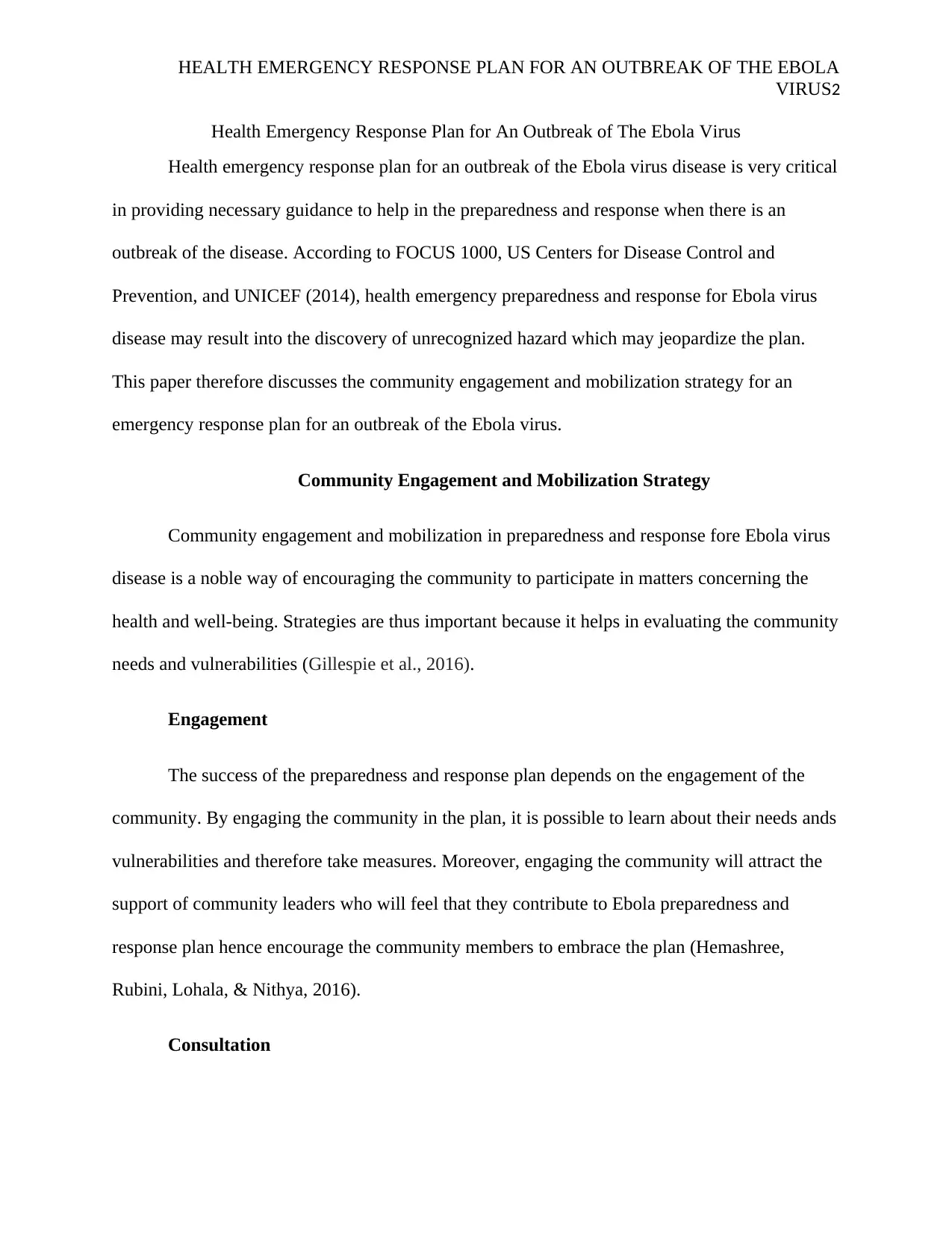
HEALTH EMERGENCY RESPONSE PLAN FOR AN OUTBREAK OF THE EBOLA
VIRUS2
Health Emergency Response Plan for An Outbreak of The Ebola Virus
Health emergency response plan for an outbreak of the Ebola virus disease is very critical
in providing necessary guidance to help in the preparedness and response when there is an
outbreak of the disease. According to FOCUS 1000, US Centers for Disease Control and
Prevention, and UNICEF (2014), health emergency preparedness and response for Ebola virus
disease may result into the discovery of unrecognized hazard which may jeopardize the plan.
This paper therefore discusses the community engagement and mobilization strategy for an
emergency response plan for an outbreak of the Ebola virus.
Community Engagement and Mobilization Strategy
Community engagement and mobilization in preparedness and response fore Ebola virus
disease is a noble way of encouraging the community to participate in matters concerning the
health and well-being. Strategies are thus important because it helps in evaluating the community
needs and vulnerabilities (Gillespie et al., 2016).
Engagement
The success of the preparedness and response plan depends on the engagement of the
community. By engaging the community in the plan, it is possible to learn about their needs ands
vulnerabilities and therefore take measures. Moreover, engaging the community will attract the
support of community leaders who will feel that they contribute to Ebola preparedness and
response plan hence encourage the community members to embrace the plan (Hemashree,
Rubini, Lohala, & Nithya, 2016).
Consultation
VIRUS2
Health Emergency Response Plan for An Outbreak of The Ebola Virus
Health emergency response plan for an outbreak of the Ebola virus disease is very critical
in providing necessary guidance to help in the preparedness and response when there is an
outbreak of the disease. According to FOCUS 1000, US Centers for Disease Control and
Prevention, and UNICEF (2014), health emergency preparedness and response for Ebola virus
disease may result into the discovery of unrecognized hazard which may jeopardize the plan.
This paper therefore discusses the community engagement and mobilization strategy for an
emergency response plan for an outbreak of the Ebola virus.
Community Engagement and Mobilization Strategy
Community engagement and mobilization in preparedness and response fore Ebola virus
disease is a noble way of encouraging the community to participate in matters concerning the
health and well-being. Strategies are thus important because it helps in evaluating the community
needs and vulnerabilities (Gillespie et al., 2016).
Engagement
The success of the preparedness and response plan depends on the engagement of the
community. By engaging the community in the plan, it is possible to learn about their needs ands
vulnerabilities and therefore take measures. Moreover, engaging the community will attract the
support of community leaders who will feel that they contribute to Ebola preparedness and
response plan hence encourage the community members to embrace the plan (Hemashree,
Rubini, Lohala, & Nithya, 2016).
Consultation
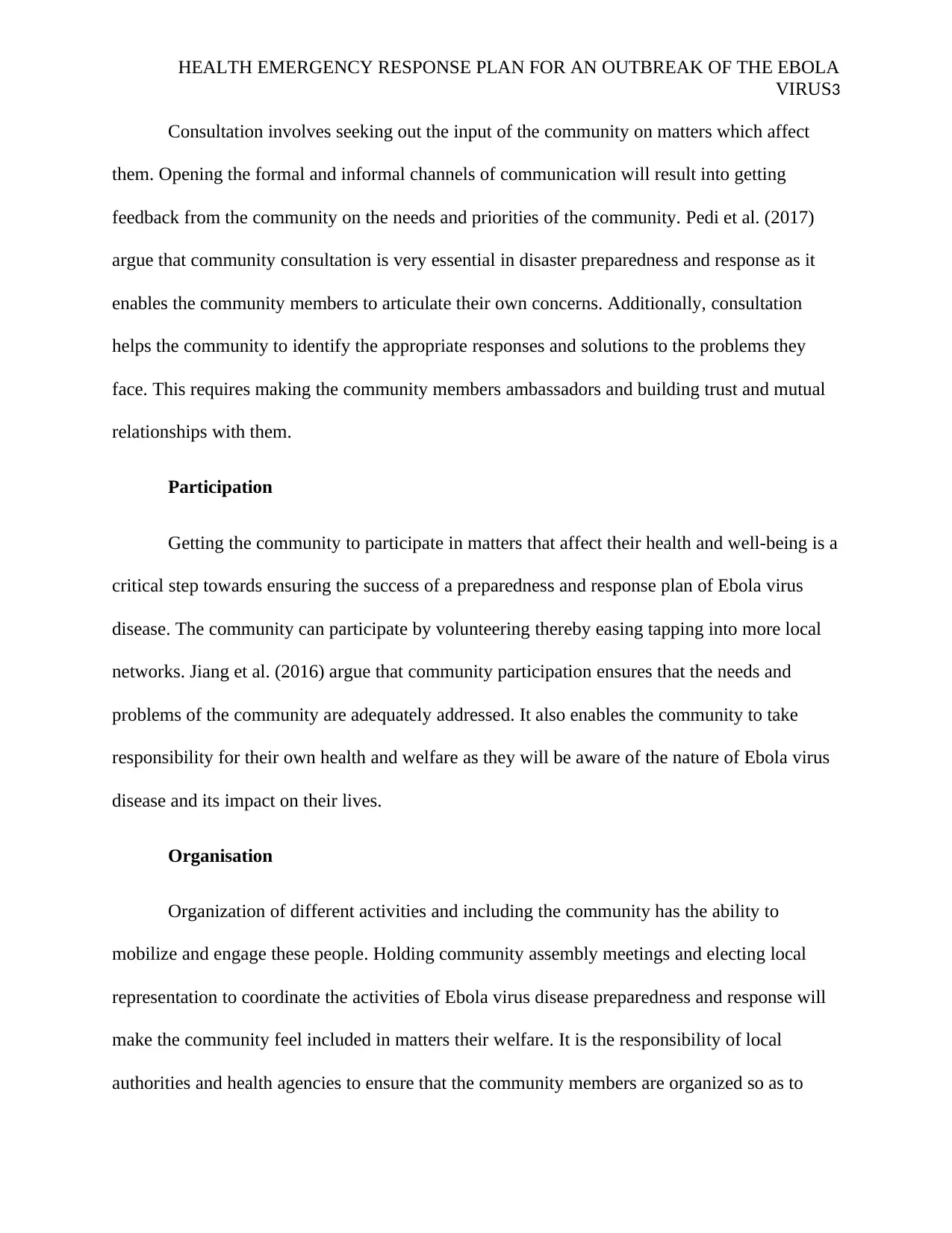
HEALTH EMERGENCY RESPONSE PLAN FOR AN OUTBREAK OF THE EBOLA
VIRUS3
Consultation involves seeking out the input of the community on matters which affect
them. Opening the formal and informal channels of communication will result into getting
feedback from the community on the needs and priorities of the community. Pedi et al. (2017)
argue that community consultation is very essential in disaster preparedness and response as it
enables the community members to articulate their own concerns. Additionally, consultation
helps the community to identify the appropriate responses and solutions to the problems they
face. This requires making the community members ambassadors and building trust and mutual
relationships with them.
Participation
Getting the community to participate in matters that affect their health and well-being is a
critical step towards ensuring the success of a preparedness and response plan of Ebola virus
disease. The community can participate by volunteering thereby easing tapping into more local
networks. Jiang et al. (2016) argue that community participation ensures that the needs and
problems of the community are adequately addressed. It also enables the community to take
responsibility for their own health and welfare as they will be aware of the nature of Ebola virus
disease and its impact on their lives.
Organisation
Organization of different activities and including the community has the ability to
mobilize and engage these people. Holding community assembly meetings and electing local
representation to coordinate the activities of Ebola virus disease preparedness and response will
make the community feel included in matters their welfare. It is the responsibility of local
authorities and health agencies to ensure that the community members are organized so as to
VIRUS3
Consultation involves seeking out the input of the community on matters which affect
them. Opening the formal and informal channels of communication will result into getting
feedback from the community on the needs and priorities of the community. Pedi et al. (2017)
argue that community consultation is very essential in disaster preparedness and response as it
enables the community members to articulate their own concerns. Additionally, consultation
helps the community to identify the appropriate responses and solutions to the problems they
face. This requires making the community members ambassadors and building trust and mutual
relationships with them.
Participation
Getting the community to participate in matters that affect their health and well-being is a
critical step towards ensuring the success of a preparedness and response plan of Ebola virus
disease. The community can participate by volunteering thereby easing tapping into more local
networks. Jiang et al. (2016) argue that community participation ensures that the needs and
problems of the community are adequately addressed. It also enables the community to take
responsibility for their own health and welfare as they will be aware of the nature of Ebola virus
disease and its impact on their lives.
Organisation
Organization of different activities and including the community has the ability to
mobilize and engage these people. Holding community assembly meetings and electing local
representation to coordinate the activities of Ebola virus disease preparedness and response will
make the community feel included in matters their welfare. It is the responsibility of local
authorities and health agencies to ensure that the community members are organized so as to
⊘ This is a preview!⊘
Do you want full access?
Subscribe today to unlock all pages.

Trusted by 1+ million students worldwide
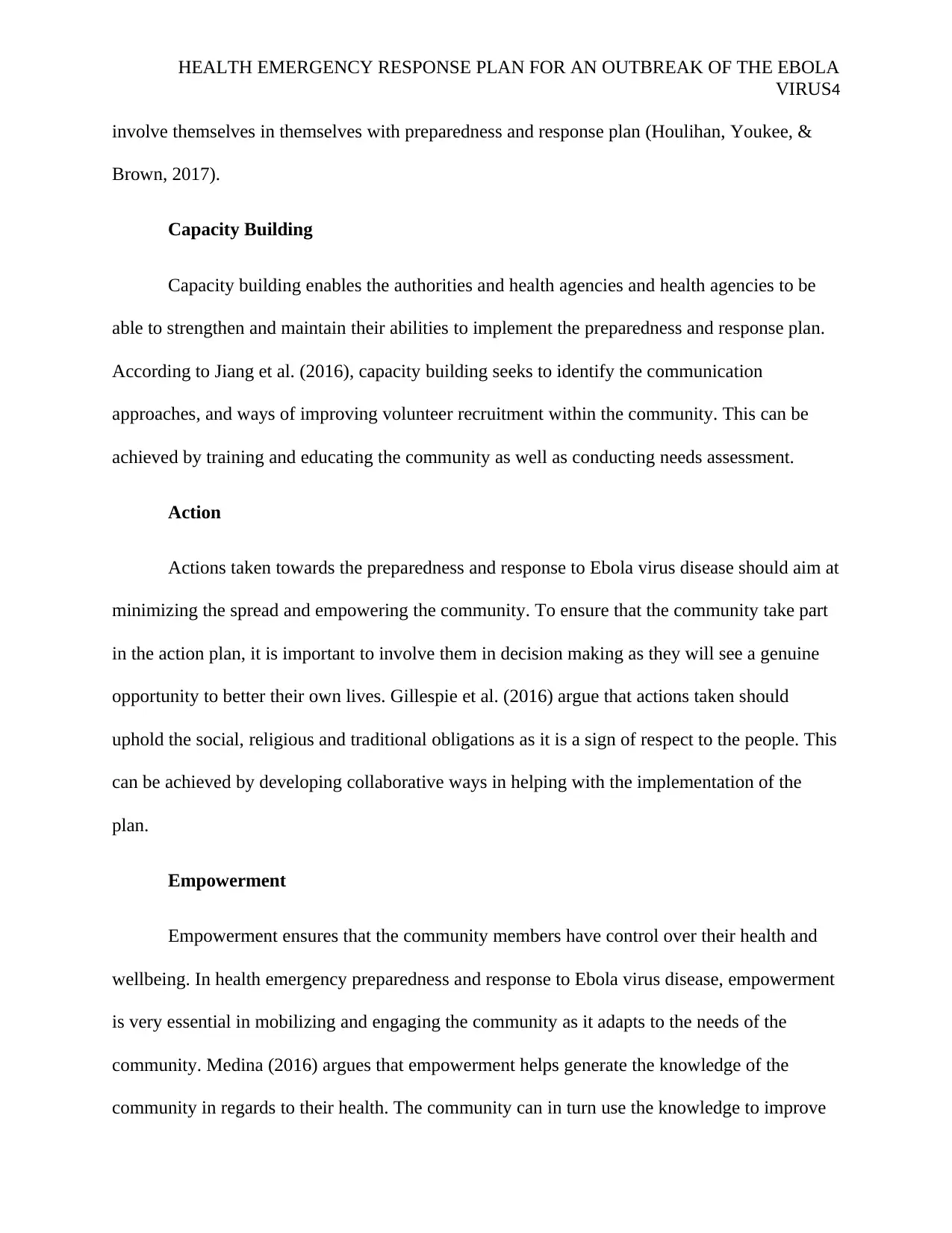
HEALTH EMERGENCY RESPONSE PLAN FOR AN OUTBREAK OF THE EBOLA
VIRUS4
involve themselves in themselves with preparedness and response plan (Houlihan, Youkee, &
Brown, 2017).
Capacity Building
Capacity building enables the authorities and health agencies and health agencies to be
able to strengthen and maintain their abilities to implement the preparedness and response plan.
According to Jiang et al. (2016), capacity building seeks to identify the communication
approaches, and ways of improving volunteer recruitment within the community. This can be
achieved by training and educating the community as well as conducting needs assessment.
Action
Actions taken towards the preparedness and response to Ebola virus disease should aim at
minimizing the spread and empowering the community. To ensure that the community take part
in the action plan, it is important to involve them in decision making as they will see a genuine
opportunity to better their own lives. Gillespie et al. (2016) argue that actions taken should
uphold the social, religious and traditional obligations as it is a sign of respect to the people. This
can be achieved by developing collaborative ways in helping with the implementation of the
plan.
Empowerment
Empowerment ensures that the community members have control over their health and
wellbeing. In health emergency preparedness and response to Ebola virus disease, empowerment
is very essential in mobilizing and engaging the community as it adapts to the needs of the
community. Medina (2016) argues that empowerment helps generate the knowledge of the
community in regards to their health. The community can in turn use the knowledge to improve
VIRUS4
involve themselves in themselves with preparedness and response plan (Houlihan, Youkee, &
Brown, 2017).
Capacity Building
Capacity building enables the authorities and health agencies and health agencies to be
able to strengthen and maintain their abilities to implement the preparedness and response plan.
According to Jiang et al. (2016), capacity building seeks to identify the communication
approaches, and ways of improving volunteer recruitment within the community. This can be
achieved by training and educating the community as well as conducting needs assessment.
Action
Actions taken towards the preparedness and response to Ebola virus disease should aim at
minimizing the spread and empowering the community. To ensure that the community take part
in the action plan, it is important to involve them in decision making as they will see a genuine
opportunity to better their own lives. Gillespie et al. (2016) argue that actions taken should
uphold the social, religious and traditional obligations as it is a sign of respect to the people. This
can be achieved by developing collaborative ways in helping with the implementation of the
plan.
Empowerment
Empowerment ensures that the community members have control over their health and
wellbeing. In health emergency preparedness and response to Ebola virus disease, empowerment
is very essential in mobilizing and engaging the community as it adapts to the needs of the
community. Medina (2016) argues that empowerment helps generate the knowledge of the
community in regards to their health. The community can in turn use the knowledge to improve
Paraphrase This Document
Need a fresh take? Get an instant paraphrase of this document with our AI Paraphraser
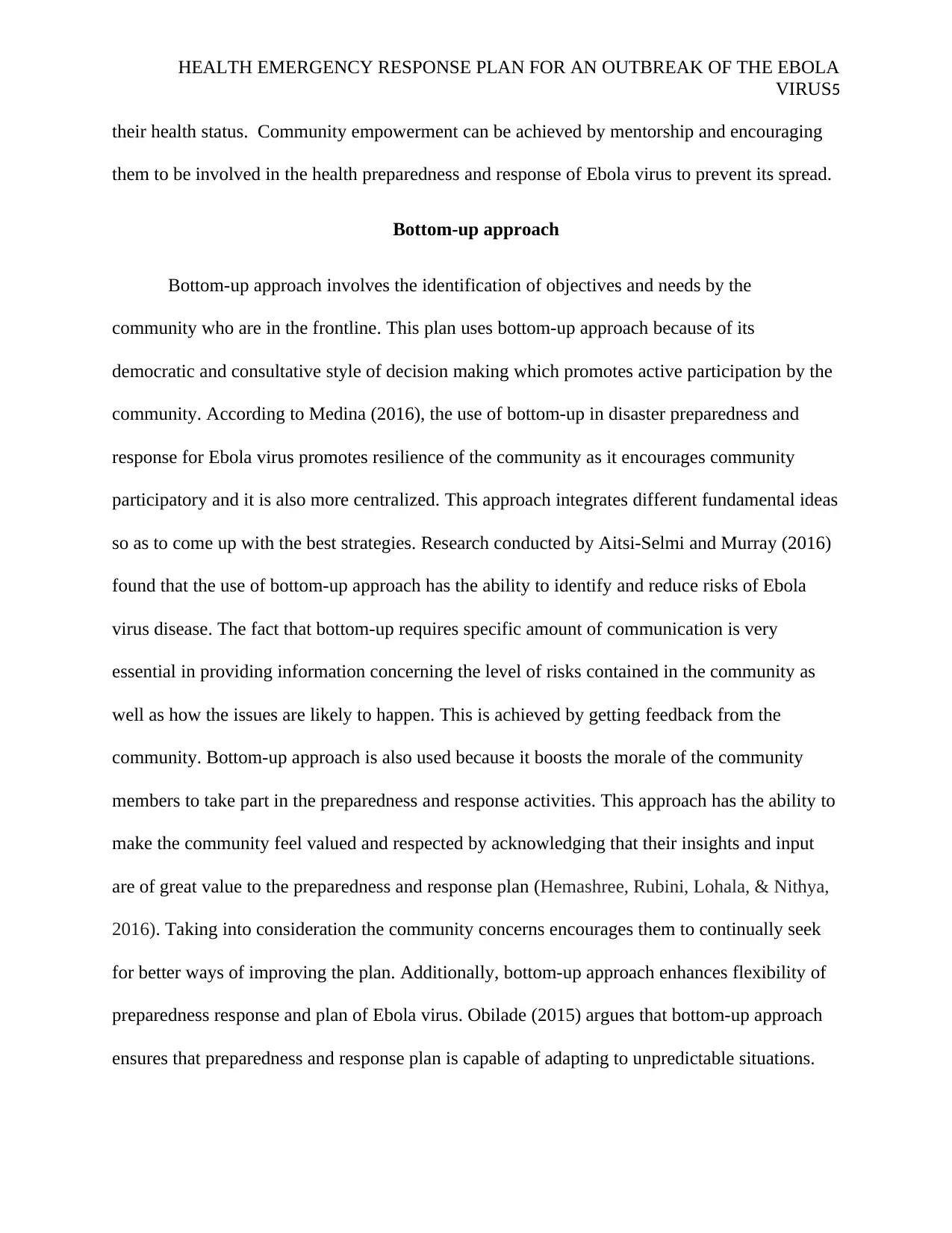
HEALTH EMERGENCY RESPONSE PLAN FOR AN OUTBREAK OF THE EBOLA
VIRUS5
their health status. Community empowerment can be achieved by mentorship and encouraging
them to be involved in the health preparedness and response of Ebola virus to prevent its spread.
Bottom-up approach
Bottom-up approach involves the identification of objectives and needs by the
community who are in the frontline. This plan uses bottom-up approach because of its
democratic and consultative style of decision making which promotes active participation by the
community. According to Medina (2016), the use of bottom-up in disaster preparedness and
response for Ebola virus promotes resilience of the community as it encourages community
participatory and it is also more centralized. This approach integrates different fundamental ideas
so as to come up with the best strategies. Research conducted by Aitsi-Selmi and Murray (2016)
found that the use of bottom-up approach has the ability to identify and reduce risks of Ebola
virus disease. The fact that bottom-up requires specific amount of communication is very
essential in providing information concerning the level of risks contained in the community as
well as how the issues are likely to happen. This is achieved by getting feedback from the
community. Bottom-up approach is also used because it boosts the morale of the community
members to take part in the preparedness and response activities. This approach has the ability to
make the community feel valued and respected by acknowledging that their insights and input
are of great value to the preparedness and response plan (Hemashree, Rubini, Lohala, & Nithya,
2016). Taking into consideration the community concerns encourages them to continually seek
for better ways of improving the plan. Additionally, bottom-up approach enhances flexibility of
preparedness response and plan of Ebola virus. Obilade (2015) argues that bottom-up approach
ensures that preparedness and response plan is capable of adapting to unpredictable situations.
VIRUS5
their health status. Community empowerment can be achieved by mentorship and encouraging
them to be involved in the health preparedness and response of Ebola virus to prevent its spread.
Bottom-up approach
Bottom-up approach involves the identification of objectives and needs by the
community who are in the frontline. This plan uses bottom-up approach because of its
democratic and consultative style of decision making which promotes active participation by the
community. According to Medina (2016), the use of bottom-up in disaster preparedness and
response for Ebola virus promotes resilience of the community as it encourages community
participatory and it is also more centralized. This approach integrates different fundamental ideas
so as to come up with the best strategies. Research conducted by Aitsi-Selmi and Murray (2016)
found that the use of bottom-up approach has the ability to identify and reduce risks of Ebola
virus disease. The fact that bottom-up requires specific amount of communication is very
essential in providing information concerning the level of risks contained in the community as
well as how the issues are likely to happen. This is achieved by getting feedback from the
community. Bottom-up approach is also used because it boosts the morale of the community
members to take part in the preparedness and response activities. This approach has the ability to
make the community feel valued and respected by acknowledging that their insights and input
are of great value to the preparedness and response plan (Hemashree, Rubini, Lohala, & Nithya,
2016). Taking into consideration the community concerns encourages them to continually seek
for better ways of improving the plan. Additionally, bottom-up approach enhances flexibility of
preparedness response and plan of Ebola virus. Obilade (2015) argues that bottom-up approach
ensures that preparedness and response plan is capable of adapting to unpredictable situations.
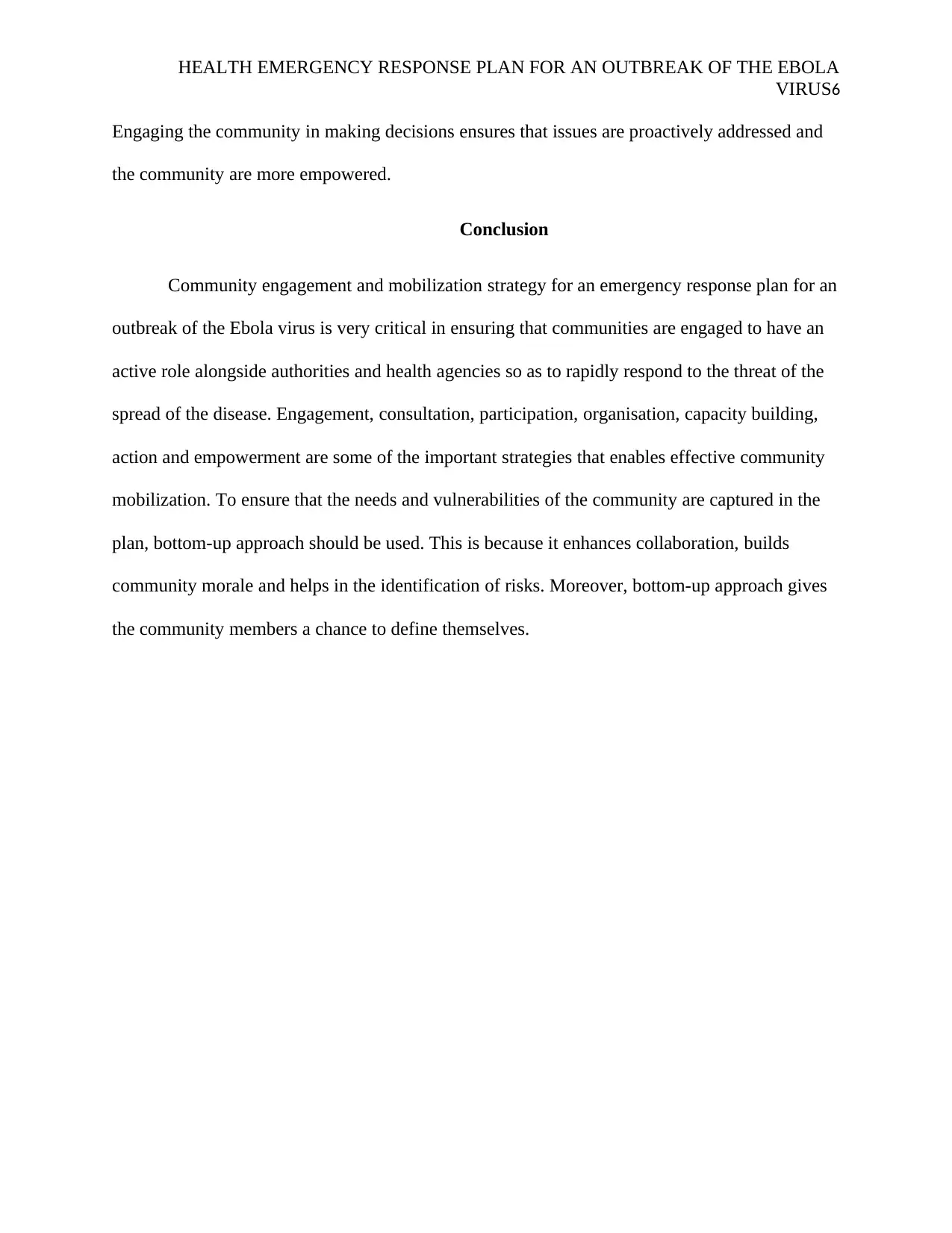
HEALTH EMERGENCY RESPONSE PLAN FOR AN OUTBREAK OF THE EBOLA
VIRUS6
Engaging the community in making decisions ensures that issues are proactively addressed and
the community are more empowered.
Conclusion
Community engagement and mobilization strategy for an emergency response plan for an
outbreak of the Ebola virus is very critical in ensuring that communities are engaged to have an
active role alongside authorities and health agencies so as to rapidly respond to the threat of the
spread of the disease. Engagement, consultation, participation, organisation, capacity building,
action and empowerment are some of the important strategies that enables effective community
mobilization. To ensure that the needs and vulnerabilities of the community are captured in the
plan, bottom-up approach should be used. This is because it enhances collaboration, builds
community morale and helps in the identification of risks. Moreover, bottom-up approach gives
the community members a chance to define themselves.
VIRUS6
Engaging the community in making decisions ensures that issues are proactively addressed and
the community are more empowered.
Conclusion
Community engagement and mobilization strategy for an emergency response plan for an
outbreak of the Ebola virus is very critical in ensuring that communities are engaged to have an
active role alongside authorities and health agencies so as to rapidly respond to the threat of the
spread of the disease. Engagement, consultation, participation, organisation, capacity building,
action and empowerment are some of the important strategies that enables effective community
mobilization. To ensure that the needs and vulnerabilities of the community are captured in the
plan, bottom-up approach should be used. This is because it enhances collaboration, builds
community morale and helps in the identification of risks. Moreover, bottom-up approach gives
the community members a chance to define themselves.
⊘ This is a preview!⊘
Do you want full access?
Subscribe today to unlock all pages.

Trusted by 1+ million students worldwide
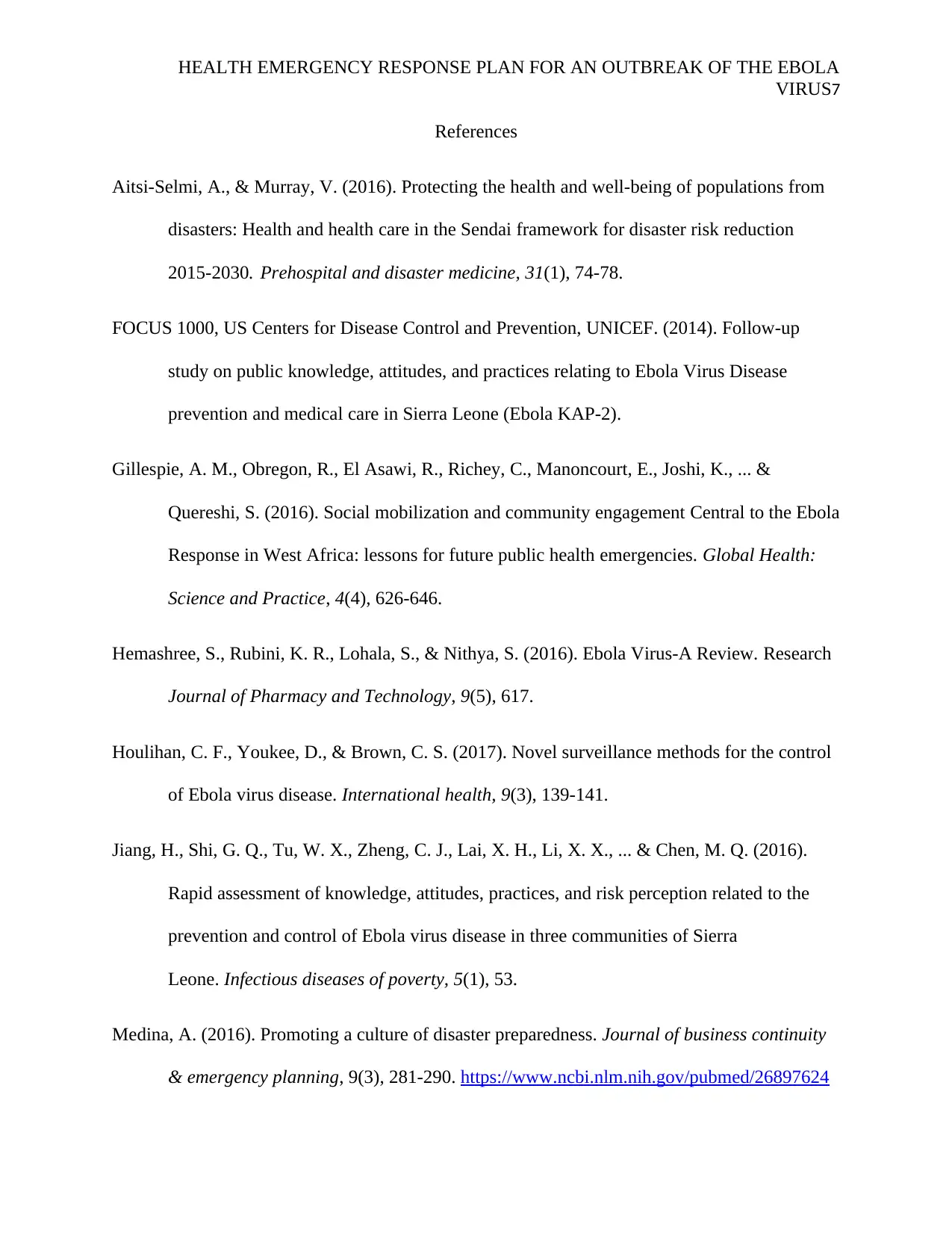
HEALTH EMERGENCY RESPONSE PLAN FOR AN OUTBREAK OF THE EBOLA
VIRUS7
References
Aitsi-Selmi, A., & Murray, V. (2016). Protecting the health and well-being of populations from
disasters: Health and health care in the Sendai framework for disaster risk reduction
2015-2030. Prehospital and disaster medicine, 31(1), 74-78.
FOCUS 1000, US Centers for Disease Control and Prevention, UNICEF. (2014). Follow-up
study on public knowledge, attitudes, and practices relating to Ebola Virus Disease
prevention and medical care in Sierra Leone (Ebola KAP-2).
Gillespie, A. M., Obregon, R., El Asawi, R., Richey, C., Manoncourt, E., Joshi, K., ... &
Quereshi, S. (2016). Social mobilization and community engagement Central to the Ebola
Response in West Africa: lessons for future public health emergencies. Global Health:
Science and Practice, 4(4), 626-646.
Hemashree, S., Rubini, K. R., Lohala, S., & Nithya, S. (2016). Ebola Virus-A Review. Research
Journal of Pharmacy and Technology, 9(5), 617.
Houlihan, C. F., Youkee, D., & Brown, C. S. (2017). Novel surveillance methods for the control
of Ebola virus disease. International health, 9(3), 139-141.
Jiang, H., Shi, G. Q., Tu, W. X., Zheng, C. J., Lai, X. H., Li, X. X., ... & Chen, M. Q. (2016).
Rapid assessment of knowledge, attitudes, practices, and risk perception related to the
prevention and control of Ebola virus disease in three communities of Sierra
Leone. Infectious diseases of poverty, 5(1), 53.
Medina, A. (2016). Promoting a culture of disaster preparedness. Journal of business continuity
& emergency planning, 9(3), 281-290. https://www.ncbi.nlm.nih.gov/pubmed/26897624
VIRUS7
References
Aitsi-Selmi, A., & Murray, V. (2016). Protecting the health and well-being of populations from
disasters: Health and health care in the Sendai framework for disaster risk reduction
2015-2030. Prehospital and disaster medicine, 31(1), 74-78.
FOCUS 1000, US Centers for Disease Control and Prevention, UNICEF. (2014). Follow-up
study on public knowledge, attitudes, and practices relating to Ebola Virus Disease
prevention and medical care in Sierra Leone (Ebola KAP-2).
Gillespie, A. M., Obregon, R., El Asawi, R., Richey, C., Manoncourt, E., Joshi, K., ... &
Quereshi, S. (2016). Social mobilization and community engagement Central to the Ebola
Response in West Africa: lessons for future public health emergencies. Global Health:
Science and Practice, 4(4), 626-646.
Hemashree, S., Rubini, K. R., Lohala, S., & Nithya, S. (2016). Ebola Virus-A Review. Research
Journal of Pharmacy and Technology, 9(5), 617.
Houlihan, C. F., Youkee, D., & Brown, C. S. (2017). Novel surveillance methods for the control
of Ebola virus disease. International health, 9(3), 139-141.
Jiang, H., Shi, G. Q., Tu, W. X., Zheng, C. J., Lai, X. H., Li, X. X., ... & Chen, M. Q. (2016).
Rapid assessment of knowledge, attitudes, practices, and risk perception related to the
prevention and control of Ebola virus disease in three communities of Sierra
Leone. Infectious diseases of poverty, 5(1), 53.
Medina, A. (2016). Promoting a culture of disaster preparedness. Journal of business continuity
& emergency planning, 9(3), 281-290. https://www.ncbi.nlm.nih.gov/pubmed/26897624
Paraphrase This Document
Need a fresh take? Get an instant paraphrase of this document with our AI Paraphraser
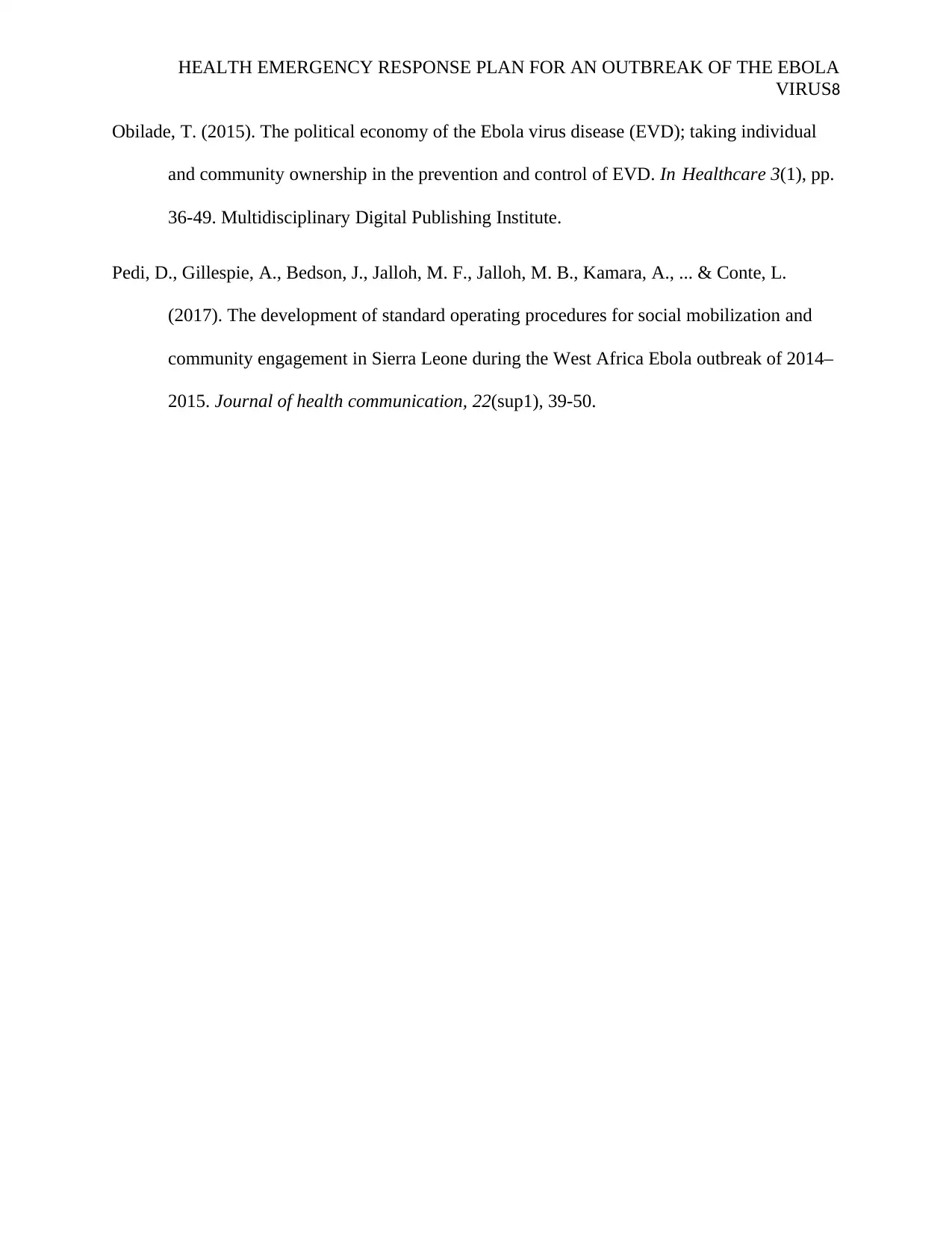
HEALTH EMERGENCY RESPONSE PLAN FOR AN OUTBREAK OF THE EBOLA
VIRUS8
Obilade, T. (2015). The political economy of the Ebola virus disease (EVD); taking individual
and community ownership in the prevention and control of EVD. In Healthcare 3(1), pp.
36-49. Multidisciplinary Digital Publishing Institute.
Pedi, D., Gillespie, A., Bedson, J., Jalloh, M. F., Jalloh, M. B., Kamara, A., ... & Conte, L.
(2017). The development of standard operating procedures for social mobilization and
community engagement in Sierra Leone during the West Africa Ebola outbreak of 2014–
2015. Journal of health communication, 22(sup1), 39-50.
VIRUS8
Obilade, T. (2015). The political economy of the Ebola virus disease (EVD); taking individual
and community ownership in the prevention and control of EVD. In Healthcare 3(1), pp.
36-49. Multidisciplinary Digital Publishing Institute.
Pedi, D., Gillespie, A., Bedson, J., Jalloh, M. F., Jalloh, M. B., Kamara, A., ... & Conte, L.
(2017). The development of standard operating procedures for social mobilization and
community engagement in Sierra Leone during the West Africa Ebola outbreak of 2014–
2015. Journal of health communication, 22(sup1), 39-50.
1 out of 8
Related Documents
Your All-in-One AI-Powered Toolkit for Academic Success.
+13062052269
info@desklib.com
Available 24*7 on WhatsApp / Email
![[object Object]](/_next/static/media/star-bottom.7253800d.svg)
Unlock your academic potential
Copyright © 2020–2025 A2Z Services. All Rights Reserved. Developed and managed by ZUCOL.




